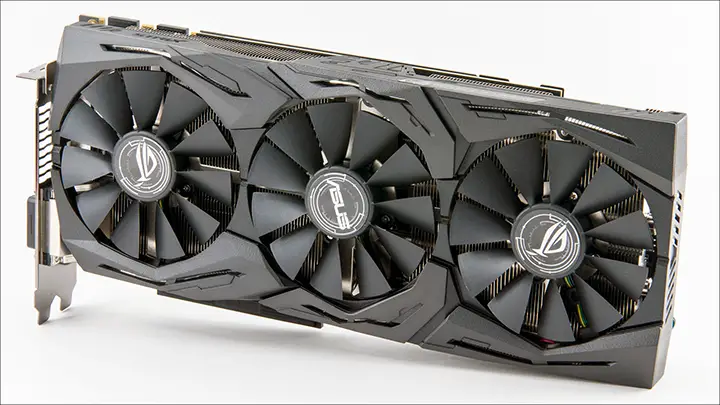We can say we have such certainty that this card does not need a third fan, and that is pretty much would be a waste for most people (unless you are highly noise sensitive) because the fin array takes full advantage of the room it has to work with.

As you can see it is two large cooling fin arrays that are paired with either two (rear) or three (front fin array) 6mm nickel-plated heatpipes. Each of those heatpipes (when in the less than optimal horizontal orientation) can easily handle in excess of 40 watts of heat. Each. There are six of them. Thus, as long as the fin array can keep up with their cooling performance… nothing else is needed beyond this level of overkill.

Since we were curious, we actually measured the dimensions of the fin arrays. First, though, we have to point out the insanely good engineering baked into the fin array. Typically, video card fin arrays are a slab-sided affair, and they lack the static pressure reducing ‘face’ carved into them… as the design team (wrongly) feels that the reduction in surface area is not worth the reduction in static pressure. MSI has included two excellent “faces” in their fin array. Both of which will focus the air and ensure that every last watt of heat is converted effortlessly and quietly as possible into hot air.

Moving on. Both fin arrays are about 99 to 100mm wide (~117mm less ~3.9mm x2).

Both fin arrays are about 27mm tall.

The front array is about 103mm long.

The rear array is about 75mm

Doing the math that means the front Twin Frozr cooling array has approximately 2,781cm of surface area, and the rear most has 2,025. That is a lot of potential cooling surface for a piddly little 60Ti class core. In fact, it is edging into overkill territory, just the way it should be. Color us impressed.

Moving on. The power delivery subsystem is a 6 6-phase affair, which is for a 60Ti-class card. Which, once again for a sub-200-watt card, is overkill. So, while it may not be 8 or 12 or 16 or 10-billion phases, it is more than good enough for this class of card. It will provide clean, stable power even when the card is ‘stressed’. As such, we have no problems with this level of phases and consider it a good example of balancing MSRP vs performance.

Lastly, some will like the fact that this card may use the PCIe x16 form-factor but is only electrically a PCIe 5.0 x8 card. On the one hand, this removes worry over ‘performance loss’ when one uses it in the real world in a system where the NVMe M.2 PCIe 5.0×4 drives are forcing the GPU into x8 mode. On the other hand, it just highlights the level of disrespect NVIDIA has towards their x60Ti class. They are hobbling the core and all but ensuring that it can never, ever “steal” sales from their teacher’s pet x70 class. Ugh. This is a pet peeve of ours, and all 5060Ti’s are going to be x8, so we cannot knock MSI for it. They are working with the hand they have been dealt… and doing a pretty darn good job at it, we might add.

Overall, we like this card a lot. It looks rather good. It is built to a very high standard with a ton of engineering tweaks and optimizations baked into it; and, generally speaking, it appears to be a great “all-rounder” option for typical mainstream buyers. One that should provide years of consistent performance. Be it noise, temperature, or pixel power standards, you judge it against… it should offer more than merely ‘good enough’ for the average buyer and instead be firmly in the good end of the spectrum.








